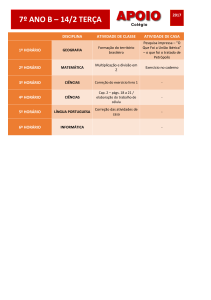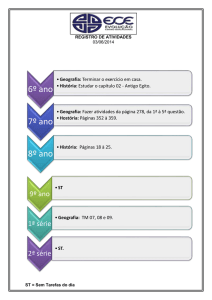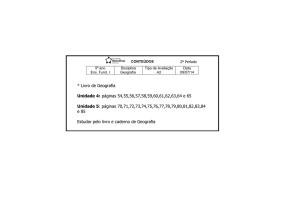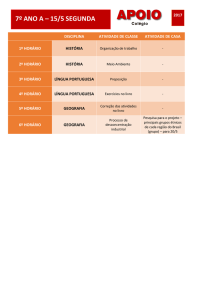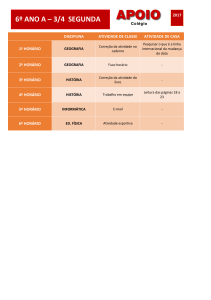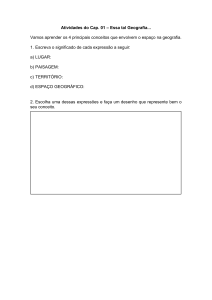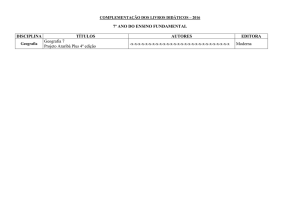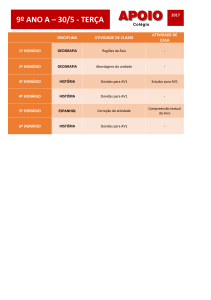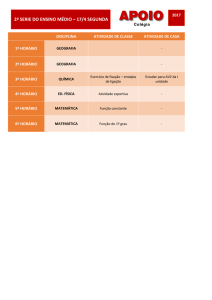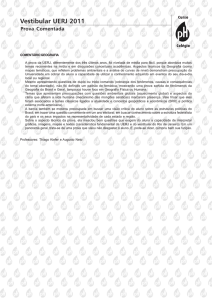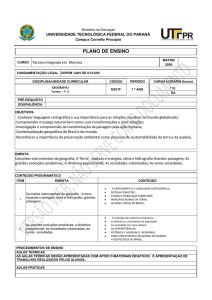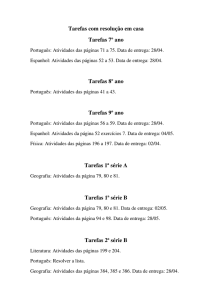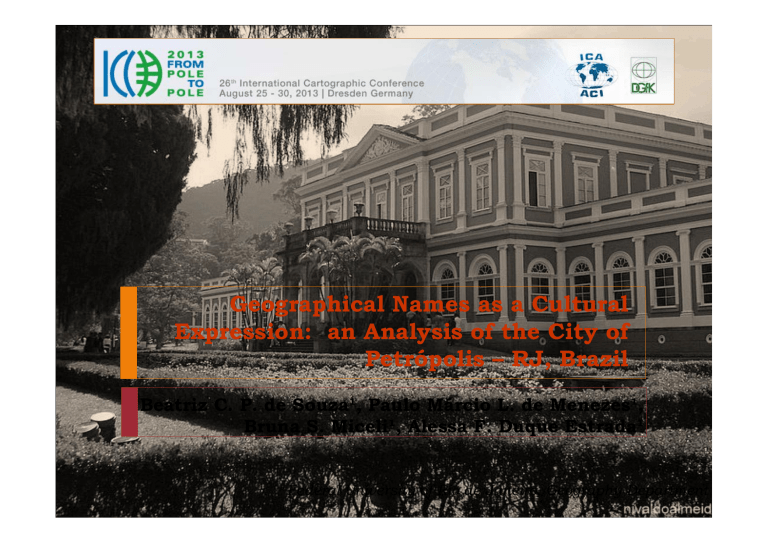
Geographical Names as a Cultural
Expression: an Analysis of the City of
Petrópolis – RJ, Brazil
Beatriz C. P. de Souza¹, Paulo Márcio L. de Menezes¹,
Bruna S. Miceli¹, Alessa F. Duque Estrada¹
¹ Federal University of Rio de Janeiro, Geography Department
Summary
1. Introduction
2. The City of Petrópolis - RJ
3. The acquisition of the geographical names and the
systematization of the analysis
4. Toponym as a Cultural Expression
5. The geographical names of Petrópolis: Cultural origin
and Motivations
6. Final Considerations and Future Stages
7. References
1. Introduction
Toponym Research: multidisciplinary; facilitate the
establishment of various relations with the cultural, social,
political, economical and natural aspects of a studied area;
Special importance for Geographic and Cartographic
Sciences:
“names may reflect a ‘humanized landscape’, through its own
personification, resulting in a separation and differentiation from
any other land. Based on this, geographical names can display a
fundamental geographic language that indicates numerous aspects
about a place. (MENEZES e SANTOS, 2006)”
1. Introdução
Objectives:
Analyze
the cultural origins of the current geographical
names of the city of Petrópolis with the aim of verifying
the influence of German immigration;
Identify,
by the toponymic motivations, relations between
the human being and the place;
2. The City of Petrópolis - RJ
2. The City of Petrópolis - RJ
Petrópolis has an important historical legate in the national
perspective since, in the second half of the nineteenth century,
it was used as summer residence for the Imperial Family;
The effective settlement of Petrópolis has intimate relationship
with the affection that D. Pedro I had for the location. He met
the place in 1822;
D. Pedro I abdicated the throne in 1831. In 1834, he passed
away before the actual construction of his palace;
In 1843, D. Pedro II restarted the “Settlement of the Summer
Palace” and ordered the foundation of Petrópolis nominating
the German Major Júlio Frederico Köeler to coordinate this
project.
2. The City of Petrópolis - RJ
Source: www.viagensfamiliamorettipadulla.blogspot.com.br
Source: www.fonte.abril.com.br
Source: www.fotola.com/
Source: www.petropolisemcena.blogspot.com
3. The acquisition of the geographical names and
the systematization of the analysis
4. Toponym as a Cultural Expression
4. Toponym as a Cultural Expression
The geographical names are essential:
“map without names is a soulless map because a geographic
coordinate has no history, no cultural , anthropological ,
linguistic, ethnolinguist, socioeconomic aspects and games of
power.” (SANTOS, 2008)
Corrêa (2007) affirms that toponym is a significant
cultural record and expresses an effective appropriation
of space by some cultural group and so becoming an
important identity element;
4. Toponym as a Cultural Expression
The act of naming a place is essentially human,
establishing a cultural relation directly connected to its
population and the way to get to know the place or the
area.
The notion of toponymic motivation consisting of the
research of impulses that led to the emergence of the
toponym developed by Dick (1990).
5. The geographical names of Petrópolis: Cultural
origin and Motivations
Origin of the geographical names:
Origin
Quantity
Portuguese
87
Native
24
European
(Non-Lusitanian)
5
African
4
Others
1
Undetermined
4
Total
125
5. The geographical names of Petrópolis: Cultural
origin and Motivations
5. The geographical names of Petrópolis: Cultural
origin and Motivations
Toponymic Motivations:
6. Final Considerations and Future Stages
The current studied maps do not show a considerable
quantity of geographical names with a Germanic origin
Influence of scale;
The geographical names presented a strong Portuguese
influence since the majority of the toponyms are from
this language;
Concerning the toponymic motivations, it was realized
that portuguese and indigenous names have opposite
standards.
7. References
ANTUNES, Alessandra; CARVALINHOS, Patrícia. Toponímia Brasileira: Origens Históricas. In: CONGRESSO
NACIONAL DE LINGÜISTICA E FILOLOGIA, 11. 2007, Rio de Janeiro. Toponímia brasileira. Origens históricas.
Disponível em: http://www.filologia.org.br/xicnlf/ Acessado em 15/09/2010.
CLAVAL, P. “A volta do cultural” na Geografia. Mercator – Revista de Geografia da
UFC, n. 01, 2002.
CORRÊA, R. L. A Geografia Cultural e o Urbano. In: CORRÊA, R L. e ROZENDAHL, Z. (Orgs.). Introdução a
Geografia Cultural. Rio de Janeiro: Bertrand, Brasil, 2003. p. 167-187.
_______________. Temas e Caminhos da Geografia Cultural: uma breve reflexão. In: Zeny Rosendahl e Roberto
Lobato. (Org.). Temas e Caminhos da Geografia Cultural. Rio de Janeiro: EDUERJ, 2010, v.
1, p. 48-72.
CORRÊA, R. L.; ROSENDAHL, Z. Geografia Cultural: introduzindo a temática, os textos e uma agenda. In: CORRÊA,
R. L.; ROSENDAHL, Z. (Orgs.). Introdução à Geografia Cultural. 2ª ed. Rio de Janeiro: Bertrand, Brasil, 2007.
COSGROVE, D. E. Em direção a uma geografia cultural radical: problemas da teoria. Espaço e Cultura, Rio de Janeiro,
n. 3, p. 5-29, jan./jun. 1998b.
_______________. Geografia cultural do milênio. In: ROSENDAHL, Zeny; CORRÊA, R. L. Manifestações da cultura
no espaço. Rio de Janeiro: Ed. Uerj, 1999a. p. 17-46.
COSGROVE, D. E.; JACKSON, P. Novos rumos da geografia cultural. In: CORRÊA, Roberto Lobato; ROSENDAHL,
Zeny. Geografia cultural: um século (II). Rio de Janeiro: Ed. UERJ, 2000. p. 15-32.
DICK, Maria Vicentina de Paula do Amaral. A motivação toponímica e a realidade brasileira. São Paulo: Arquivo do
Estado, 1990.
7. References
FURTADO, Sebastião da Silva. A Toponímia e a Cartografia. Ministério da Guerra – Diretoria do Serviço Geográfico. Rio
de Janeiro: 1960.
HAESBAERT, R. Identidades territoriais. In: ROSENDAHL, Zeny; CORRÊA, Roberto Lobato. Manifestações da cultura no
espaço. Rio de Janeiro, Ed. Uerj, 1999. p. 169-190.
HAESBAERT, Rogério; LIMONAD, Éster. O território em tempos de globalização. Geo Uerj, Rio de Janeiro, n. 5, p. 7-19,
1999.
MATA, Sérgio da. O desencantamento da Toponímia. In: ROSENDAHL, Z. e CÔRREA, R. L. (orgs.). Geografia: Temas
sobre Cultura e Espaço. Rio de Janeiro: EdUERJ, 1998.
MENEZES, Paulo Márcio Leal de, SANTOS, Cláudio João Barreto dos. Geonímia do Brasil: Pesquisa, Reflexões e Aspectos
Relevantes. In: Revista Brasileira de Cartografia nº 58/2, 2006.
SANTOS, Cláudio João Barreto dos. Geonímia do Brasil: A Padronização dos Nomes Geográficos num Estudo de Caso dos
Municípios Fluminenses. Tese de doutorado. Rio de Janeiro: UFRJ, IGEO, 2008.
SANTOS, Cláudio João Barreto dos. A retomada da pesquisa da Geonímia do Brasil: algumas reflexões e aspectos
relevantes. Geo Uerj, Rio de Janeiro. Disponível em http://www.geouerj.com/PDF/Claudiojoao.pdf. Acesso em:
15/07/2011
SEEMANN, Jörn . Cartografia e cultura: abordagens para a geografia cultural. In: Zeny Rosendahl; Roberto Lobato Correa.
(Org.). Temas e caminhos da geografia cultural. Rio de Janeiro: Editora de UERJ, 2010, v. 1, p. 115-156.
SILVA, J. C. Memória Topográfica e Histórica sobre os Campos dos Goitaczses. 2ª ed. Rio de Janeiro:Leuzinger, 1907 ( 1ª
ed., 1819 ).
SILVA, J. Romão da. Geonomásticos Cariocas de Procedência Indígena. Secretaria Geral de Educação e Cultura do Estado
da Guanabara. Rio de Janeiro, 1961.
_______________. Denominações Indígenas na Toponímia Carioca. Rio de Janeiro: Livraria Editora Brasiliana, 1966.
TUAN, YI-FU. Place: an experiential perspective. Disponível em: <http://www.jstor.org/stable>. Acesso em: 06/04/2011.
Thank you for your
attention!
[email protected]

